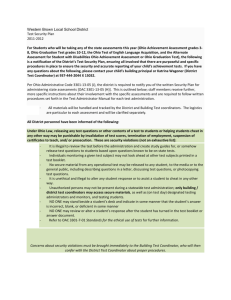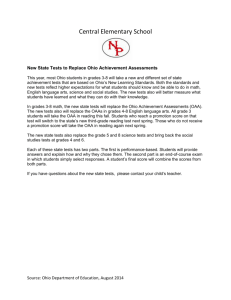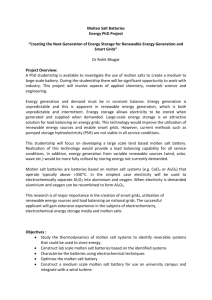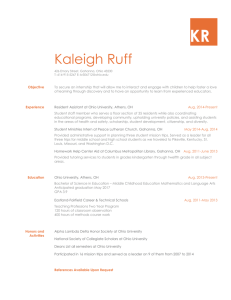TESTIMONY BEFORE THE OHIO SENATE PUBLIC UTILITIES
advertisement
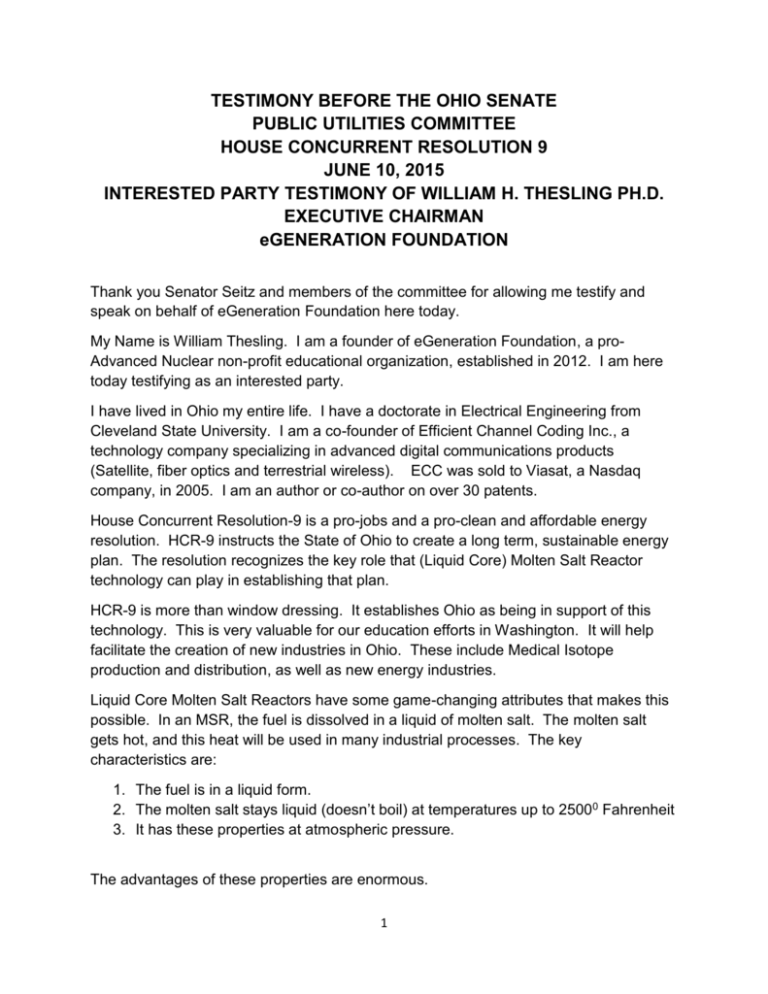
TESTIMONY BEFORE THE OHIO SENATE PUBLIC UTILITIES COMMITTEE HOUSE CONCURRENT RESOLUTION 9 JUNE 10, 2015 INTERESTED PARTY TESTIMONY OF WILLIAM H. THESLING PH.D. EXECUTIVE CHAIRMAN eGENERATION FOUNDATION Thank you Senator Seitz and members of the committee for allowing me testify and speak on behalf of eGeneration Foundation here today. My Name is William Thesling. I am a founder of eGeneration Foundation, a proAdvanced Nuclear non-profit educational organization, established in 2012. I am here today testifying as an interested party. I have lived in Ohio my entire life. I have a doctorate in Electrical Engineering from Cleveland State University. I am a co-founder of Efficient Channel Coding Inc., a technology company specializing in advanced digital communications products (Satellite, fiber optics and terrestrial wireless). ECC was sold to Viasat, a Nasdaq company, in 2005. I am an author or co-author on over 30 patents. House Concurrent Resolution-9 is a pro-jobs and a pro-clean and affordable energy resolution. HCR-9 instructs the State of Ohio to create a long term, sustainable energy plan. The resolution recognizes the key role that (Liquid Core) Molten Salt Reactor technology can play in establishing that plan. HCR-9 is more than window dressing. It establishes Ohio as being in support of this technology. This is very valuable for our education efforts in Washington. It will help facilitate the creation of new industries in Ohio. These include Medical Isotope production and distribution, as well as new energy industries. Liquid Core Molten Salt Reactors have some game-changing attributes that makes this possible. In an MSR, the fuel is dissolved in a liquid of molten salt. The molten salt gets hot, and this heat will be used in many industrial processes. The key characteristics are: 1. The fuel is in a liquid form. 2. The molten salt stays liquid (doesn’t boil) at temperatures up to 25000 Fahrenheit 3. It has these properties at atmospheric pressure. The advantages of these properties are enormous. 1 The liquid form of the core means that a “meltdown” is, by definition, impossible. The “higher actinides”, the component of nuclear waste that requires 300,000 years of sequestration from the environment, can be kept in the reactor where it will eventually fission and be eliminated. The “exhaust” from a Molten Salt Reactor can be almost entirely fission products which needs to be sequestrated from the environment for only 300 years. 300 year sequestration is a far less daunting task than 300,000 year sequestration. The liquid form is also a requirement for processing the core material. This allows for the relative ease of extraction of valuable isotopes produced via the Fission Process. Molybdenum-99 is one such isotope used in technetium generators which produce technetium-99m. This valuable substance is used in 320,000 medical diagnostic procedures in the United States each week. At present there are no domestic supplies of Molybdenum-99. Most of the supply comes from two aging reactors in Canada and the Netherlands. These reactors are roughly 50 years old and have gone down for unscheduled maintenance in the past, disrupting the availability of this valuable material. HCR-9 will help facilitate MSR development in the State of Ohio and allows for a domestic supply of this valuable, life-saving material. We’d like to see that domestic supply be in Ohio. In pursuit of this goal, the eGeneration Economic Development Corporation has presented a plan which will result in a large revenue stream from the production of Moly-99 in Ohio, and the creation of about 40,000 direct and indirect jobs in this state. The fact that molten salts do not boil and remain liquid at temperatures up to 2500 0 Fahrenheit, coupled with the fact that they exhibit this property at atmospheric pressure, results in a huge degree of inherent safety. Today’s Nuclear power has an impressive safety record. However this safety comes at a cost. Many engineered redundant systems are employed to achieve this high level of safety performance in our present light water reactors (LWR). The enhanced safety in LCMSR designs eliminates the need for many high cost engineered systems. The result is that Molten Salt Reactors can produce energy at a significantly lower cost than is the case with LWRs. HCR-9 will help facilitate the development of new, safe, low cost Nuclear Energy in Ohio. The high temperatures achievable with Molten Salt Reactors create important efficiencies in many industries. Electricity can be generated with greater efficiency. Molten salt reactors can directly drive chemical processes allowing for such things as the conversion of coal into synthetic liquid transportation fuels, including gasoline and diesel. Energy produced from Molten Salt Reactors can now enable American coal, to 2 compete economically in the transportation sector. This has the potential to eliminate foreign oil imports and lower the price of oil in the world market. As a state, Ohio is second only to Tennessee as a supplier to the nuclear industry, supplying such components as tanks, pumps, valves, pipes, and, until recently, Ohio based US Enrichment Corp. was the only US owned uranium enrichment company in the United States. The passage of HCR-9 signals to the country, and to the federal government, that Ohio is taking a leadership role in the development of new nuclear energy. Ohio’s workforce is well suited to support a nuclear renaissance based on Molten Salt Reactors. Such reactors are ideal for production via the Small Modular Reactor Model. SMRs could be produced in an Ohio factory, and shipped via truck or rail to where they would be used, and installed at the site. Such a factory would produce thousands of well paying jobs and put Ohio in the middle of energy production for the 21st century. 3

